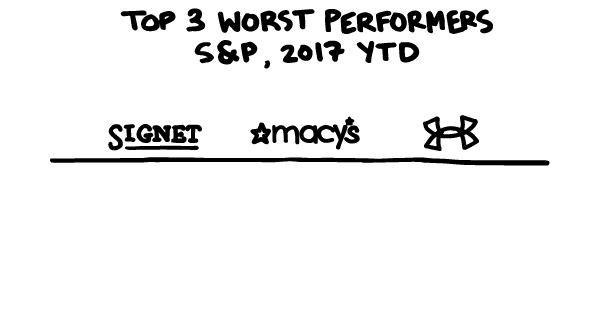
Shark Repellent — Fighting Amazon
Shark Repellent — Fighting Amazon
The markets are a remarkable thing. No one person or firm (theoretically) controls them, and they have lifelike features, but aren’t even machines, much less organic. However, they are a raw reflection of our emotions and actions without makeup. Hold up a mirror to hundreds of millions of people, and the collective reflection can be seen in the real estate, art, coffee, and stock markets.
The market also looks sectors in the eyes and provides unadulterated feedback. Right now, the markets are telling Amazon, rubbing up against $1000/share, “God, you’re hot,” and the rest of retail, “I think you’re dying.” Things are bad in retail — share performance signals the market has decided many / most are going away.

— Stagnant middle-class wages. The greatest source of good in history, the American middle class, was hit so hard it still hasn’t gotten on its feet.
— People are spending more on experiences vs. stuff.
— A retailer in Seattle is doing really well.
— There are too many stores.
Ok, yeah we get it … we (retail) are fucked. So what’s a girl (retail) to do? Some thoughts:[1]
Retool messaging to the street
Store sales is the metric retailers lead with, and they will move up again in … 2025, after 20 percent of the supply (stores) goes away. Until then, retailers that derive more than 30% of their business online (and there are a lot of them) need to refer to that channel as their core business. As such, their core business is growing double digits, and their primary source of marketing, brick and mortar, sometimes makes money and is getting cheaper, as power shifts from landlords to tenants for the first time in ten years.
Double down on growth & Amazon-immune categories
— Sephora stores in JC Penney have (sort of) kept the retailer relevant, and drive foot traffic. They also, last week, announced they were introducing a B2B unit to sell mattresses and linens to hotels.
— While Macy’s announced it was closing 68 of its 730 stores in January, at the same time they announced 50 new Blue Mercury doors in the next 24 months. In 2016 they opened four pilot concepts, 18 store-in-stores, and 24 freestanding doors.
— Home Depot has focused its fulfillment capabilities on products with non-favorable ship to weight ratios (80% of Home Depot SKUs weigh more than five pounds), playing offense against Amazon.
Organic intelligence — invest in in-store customer service
— You know, humans.
— Best Buy blue shirts, Sephora Cast, Home Depot’s golden aprons.
— Net-a-Porter has embraced messaging, as that’s increasingly how people communicate, and bots are lame.
Omnichannel through a shareholder lens
— Investments in buy online pickup in store, in-store inventory, and flexible returns make sense but have to have pass a strategic filter.
— For instance Nordstrom found it better to enable free returns, as when they pushed “return in store” they found there was a 2-3 week lag, which in many cases led to the product being already discounted or on clearance. The increase in basket size from getting the consumer in store didn’t offset the pricing challenges of getting the inventory so much later.

Narrow vs. broad
Play to Amazon’s weaknesses by curating selection vs. endless aisle assortment. Wayfair has more than 8M SKUs online vs. Home Depot’s 700,000. As Wayfair and Amazon continue to double down on endless aisle, Home Depot has narrowed SKU selection.
Need for Speed: Supply Chain
Supply chain ninjas have been more disruptive than Amazon. There has been $27.8B in value transfer in apparel from department stores to online pureplays, mostly Amazon, since 2005. Over that same period, H&M and Zara added $28.2B in incremental global revenue.
Consumers appear to view online platforms as more authentic than department stores. Asos and Farfetch are much stronger on Instagram than traditional department stores. When Fast Fashion puts a buy button on Instagram, engagement increases. When a traditional department store does, engagement decreases. Everything is moving to fast, relevant, and (see point 1) fast.
Partnerships
Brands and retailers are mostly in this together. When Panzer tanks rolled into Czechoslovakia and Poland, the British, Americans, and Russians became less allergic to partnership. There’s a tendency for traditional retailers to go aggressively at online media opps and paid merchandising to offset traditional shopper marketing dollars that were going in store. Most aren’t doing this thoughtfully, more like throwing spaghetti up against a wall and see what sticks — which pisses off brands.
Target and P&G are a model for cooperation in the face of the real enemy. When Amazon started drop-shipping from P&G’s warehouses, Target got angry. The reality is if Target had those capabilities, P&G would have presented the same opportunity. Retailers need to more tightly integrate their supply chain with key brand partners and think about flexible / integrated inventory sourcing models.
Cruel Truth
The cruel truth of capitalism is each firm has finite capital. In the case of most retailers it’s increasingly finite as their stocks plummet. The cheap capital equation of intelligence x receptors is not in most traditional retailers’ favor. To be good or great at everything is to be truly great at nothing and to compromise trying to get there. Decide where you’ll be best in class, and where you’ll be just good enough (e.g., fulfillment). Walmart’s move to end ShippingPass, their Prime copycat for $49/year, this year is evidence of this. Instead Walmart lowered free shipping minimums.
Best Bond Ever

Moore passed away this week. Born to a policeman, he joined the Royal Army at 18 and rose to captain. The oldest actor to play Bond (seven films), and knighted by Queen Elizabeth ll for his philanthropic work, Sir Roger Moore made the most of his 89 years.
Life is so rich,
Scott
A nice story about Roger Moore:
As a seven-year-old in about 1983, in the days before first-class lounges at airports, I was with my grandad at the Nice Airport and saw Roger Moore sitting at the departure gate, reading a paper. I told my granddad I’d just seen James Bond and asked if we could go over so I could get his autograph. My grandad had no idea who James Bond or Roger Moore were, so we walked over and he popped me in front of Roger Moore, with the words “My grandson says you’re famous. Can you sign this?”
As charming as you’d expect, Roger asks my name and duly signs the back of my plane ticket, a fulsome note full of best wishes. I’m ecstatic, but as we head back to our seats, I glance down at the signature. It’s hard to decipher it, but it definitely doesn’t say “James Bond.” My grandad looks at it, half figures out it says “Roger Moore” — I have absolutely no idea who that is, and my hearts sinks. I tell my grandad he’s signed it wrong, that he’s put someone else’s name — so my grandad heads back to Roger Moore, holding the ticket that he’s only just signed.
I remember staying by our seats and my grandad saying, “He says you’ve signed the wrong name. He says your name is James Bond.” Roger Moore’s face crinkled up with realisation and he beckoned me over. When I was by his knee, he leant over, looked from side to side, raised an eyebrow, and in a hushed voice said to me, “I have to sign my name as ‘Roger Moore’ because otherwise … Blofeld might find out I was here.” He asked me not to tell anyone that I’d just seen James Bond, and he thanked me for keeping his secret. I went back to our seats, my nerves absolutely jangling with delight. My grandad asked me if he’d signed “James Bond.” No, I said. I’d got it wrong. I was working with James Bond now.
1 Courtesy Maureen Mullen and L2 Retail team
0 Comments
Need more Scott in your life?
The Prof G Markets Pod now has a newsletter edition. Sign up here to receive it every Monday. What a thrill.

